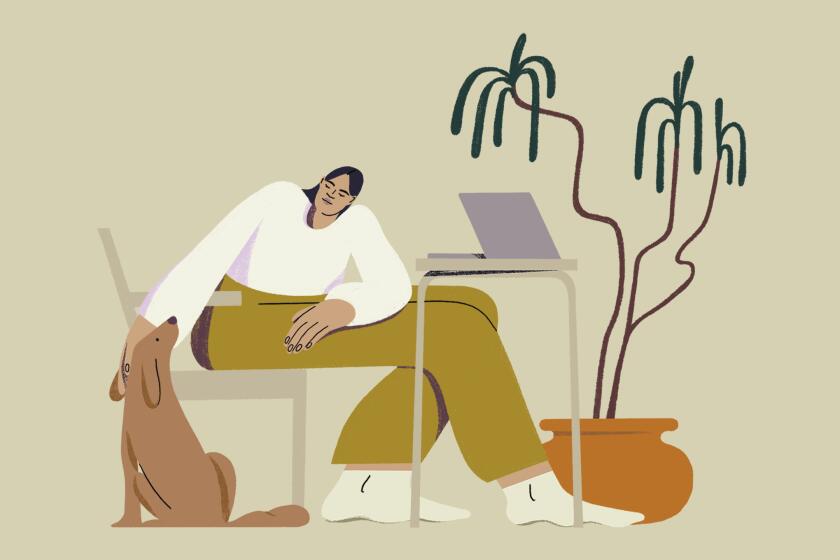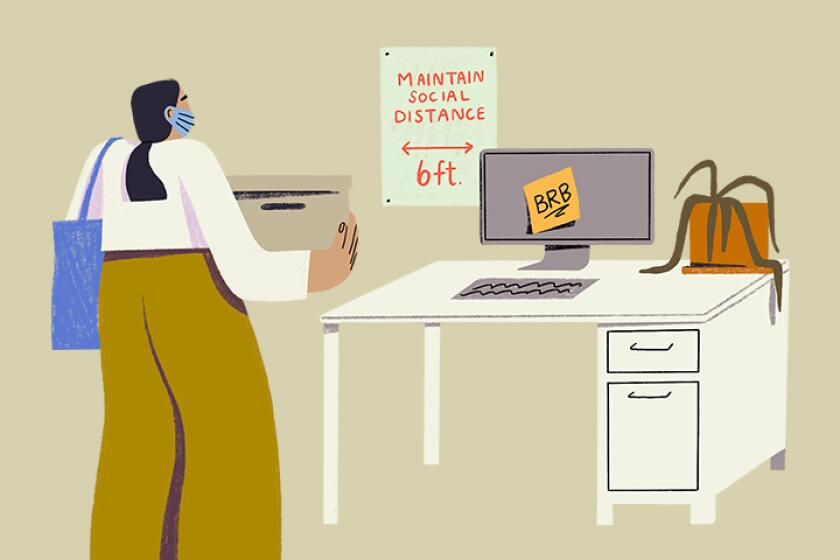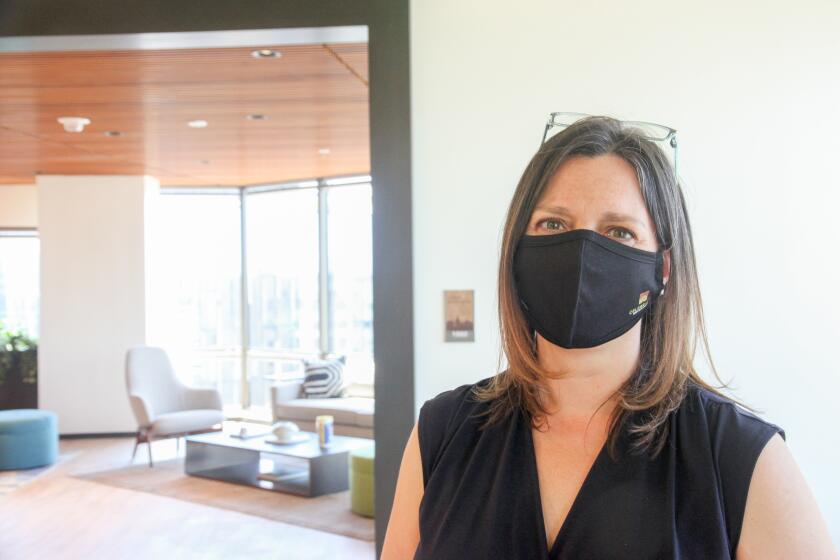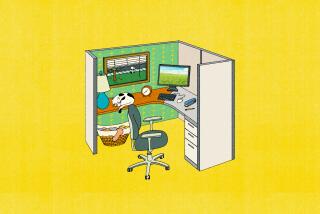Hey, boss: Don’t expect to see me 5 days a week
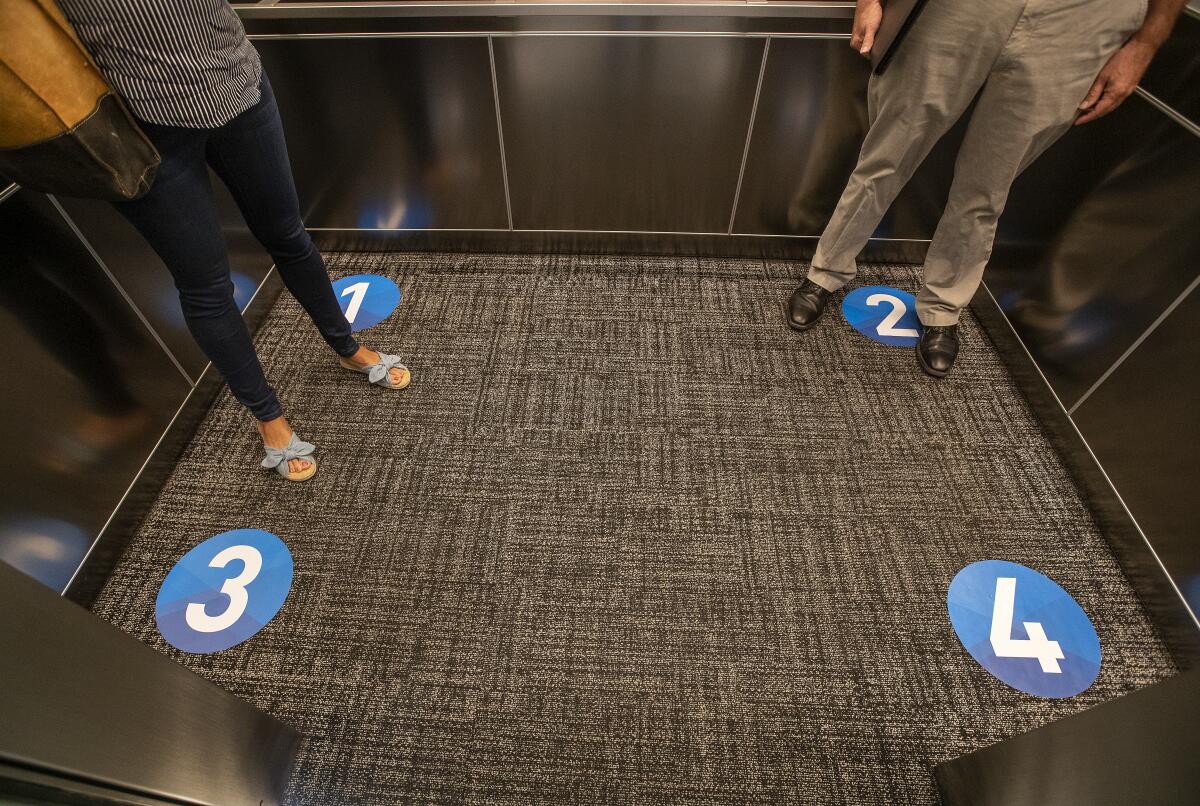
- Share via
Over 14 months of pandemic lockdown, Rebecca Jacobsson sometimes has attended two video gatherings at once — a magic trick pulled off through skillful use of the mute button and, sometimes, a hand casually draped across her mouth to mask that she was multi-Zooming.
Cross-country client meetings formerly conducted face to face now happen in different time zones in quick succession, said Jacobsson, director of digital marketing strategy for Irvine advertising agency Rhythm.
Because she is able to work remotely from her Lake Forest home, Jacobsson said she is happier and more productive, able to skip traffic jams, flights, jet lag and bad airport food, not to mention multiple wardrobe changes. Those are just a few of the reasons why the 41-year-old ad executive doesn’t want to return to her office five days a week.
“There are some days when I have meetings back to back to back,” Jacobsson said, “and if I’m going to be making a lot of calls at a desk, I’d rather be at home so I don’t have to get up, do my makeup, get dressed, make myself presentable for actually seeing people in person. I’ve become an even more efficient multitasker because of it.”
Many employees across the U.S. apparently feel the same way. Having been thrown into remote working on an emergency basis in March 2020, they say they mastered that challenge and have earned some workplace flexibility.
Just over a third of workers surveyed recently by staffing firm Robert Half said they would quit if required to return to the office full time.
Nearly half of those polled — more than 1,000 U.S. workers ages 18 and older — said that if they had to return to their offices, they would prefer a hybrid arrangement, dividing their time between the office and another location, such as home.
“Reopening doors will bring new obstacles for companies to navigate,” said Paul McDonald, senior executive director at Robert Half. “Not all employees will be ready — or willing — to return to the workplace, so staying flexible and responsive to their needs will be critical.”
Brandi Britton, Robert Half’s district president for Los Angeles and Santa Barbara counties, said workers “found in many cases they were more productive when they were home because they didn’t have any distractions. Some just aren’t willing to go back to long commutes, high parking costs and would prefer if they only had to go to the office a few days a week.”
Love remote work? Here are expert tips for how to negotiate a permanent work-from-anywhere arrangement with your boss.
Some of the biggest names in business are feeling the pushback.
Google, for instance, backtracked from an announcement that all employees would be required to be back in their offices three days a week. Google’s latest stance is that all of its employees worldwide can continue working remotely until September, when they will be allowed to choose whether to return to their pre-pandemic office or a Google office in a different city, or to work permanently away from the office, if their job description allows it.
Microsoft said it will allow employees to work from home up to 50% of the time or work remotely full time if their manager approves.
Salesforce, the parent company of Slack, has declared the traditional 9-to-5 workday dead, at least for now, and will allow workers to go to their offices one to three days a week. Facebook and Twitter said they will allow employees to work from home indefinitely.
But some experts point out that these are sometimes reluctant moves by corporate managers who would really rather see a return to the pre-pandemic normal of five days a week at the office. They just don’t think they can go there directly in the near term and perhaps are treading lightly, said Johnny C. Taylor Jr., chief executive of the Society for Human Resource Management. The group for human resources professionals has 300,000 members in 95 countries.
Over the last two years, Taylor noted, issues in the larger world, such as gender and race, were already causing division in the workplace.
“Now we’ve got the culture that works remotely and the culture that works in the office. So, we are beginning to see another divide,” Taylor said. “CEOs were having a hard time getting culture right before. Now there’s yet another culture issue that we’ve got to figure out.”
A recent poll of 577 San Diego employers found that 64% said staff won’t be allowed to work from home full time post-pandemic. Just 10% of businesses expected that most employees would work remotely three or more days a week, according to a report published last week by the San Diego Assn. of Governments.
WeWork Chief Executive Sandeep Mathrani caught some heat after he told a Wall Street Journal virtual conference last week that people who are most comfortable working from home are the “least engaged” with their jobs.
“People are happier when they come to work,” Mathrani said.
The 35-employee ad agency where Jacobsson works illustrates the changing workplace dynamic.
Before March 2020, Rhythm’s ad execs typically preferred to hash out strategies for client pitches as a group in one location. As the pandemic stretched on, some of Rhythm’s staff moved far from the office but remained full-time employees.
As COVID-19 recedes, California workers are being called back to the office. The office? Who remembers that place? And what will the return look like?

Peter Bohenek, Rhythm’s co-founder and president, said he’s had to change his thinking as a result.
“We’re a digital marketing agency, and we used to advocate having employees come to our office in Irvine to work,” he said.
Now Bohenek faces a new normal in which half the staff wants to go back to the office full time and half wants to work from home and come into the office as needed.
“Another aspect of what we think the new normal will be is going to be having more virtual, remote employees that are not necessarily even in California,” he said.
A similar workplace shift is happening at Clockwise, a San Francisco company whose automated calendar management system is used by major companies to schedule meetings and improve employee work-life balance.
“We’ve been fully remote and successful for more than a year. There’s no putting that back in the box,” Clockwise Chief Executive Matt Martin said.
“We did offer employees the option to stay completely remote,” he said. “We’re going to open the office three days a week. Two days are going to be completely remote. We’re going to balance it that way.”
Taking a slow approach makes sense, said Dr. Jason Levine, a licensed clinical psychologist in Southern California.
Workers were suddenly forced out of their offices and, for many, into a completely foreign work environment. Then and now, he said, they are probably responding the way that people do when they first enter treatment.
“When I get a new patient, they are most often, at first, very uncomfortable, very much not wanting to be there,” Levine said. “But then, in just a month, much less a year or longer, those same patients have adjusted so well to the treatment that the idea of leaving it behind was what had become scary.
“We’re talking about over a year now in which people have become acclimated to working from their homes. So the idea of going back to an office has all of these unknowns — and change in and of itself is stressful — even if it represents a positive step in the fight against this virus.”
The office beckons. What rights and protections do you have? Will safety and vaccine issues in the workplace prompt lawsuits?
Los Angeles resident Ariel Padilla recalls joking two years ago with a friend at a Bay Area tech startup where remote working was the norm: “I remember him asking me, ‘Wait, so you really go into work every day?’ I was like, ‘Dude, I’m not the weird one here, you’re the weird one.’
“Now, I totally get why he was asking me. I love my job and it’s rad, but I can’t imagine having to go to the office every day.”
Padilla, who builds digital models for a construction company, discovered he can easily work at home because he has the proper equipment. The arrangement has been more relaxing and has helped him save time and money.
Padilla’s employer hasn’t yet solidified plans for a return to the office, and “there has been talk about a transition to a semi-remote condition where a few of us go on site a few times a week,” he said. “Personally I’m never going back to a fully in-person job, even if it means leaving my current job.”
Returning to the office isn’t the only concern. It’s also getting there, for some people who take a bus or train.
A worker who commuted by Metrolink to a Southern California entertainment giant said he is worried about plans to bring employees back this summer.
“I am absolutely not comfortable taking mass transit for the foreseeable future,” said the worker, who didn’t want his name used for fear of corporate retaliation.
“I’m also not comfortable being in an indoor environment with people who aren’t vaccinated,” he said. “Vaccine hesitancy is creating more uncertainty for me.”
Network engineer Jonathan Tan is even more unhappy. The multistate healthcare foundation where he works has ordered everyone back to the office.
“They expect us back in person every day all day,” Tan said. “I do not like it at all, and I will be looking for a new job.”
There will also be an abrupt transition for Charles Greenwood, who works for a nonprofit that monitors university research and training grants. Greenwood’s employer requires staff back in the office full time when their coronavirus vaccines are in full effect.
“I’m rather disappointed by this decision,” Greenwood said, but he intends to comply.
Expect huge piles of mail, awkward interactions with colleagues you haven’t seen in months, and artifacts from the Before Times. Oh, and don’t open the office fridge.
Gary Holbrook, 67, works as a software developer for a Southern California medical products design and manufacturing company that had said it expected its employees to return to the office in July. Since then, however, the company has pushed the office restart date until September, “possibly,” Holbrook thinks, “for the younger employees who have been slow in getting vaccinated.”
“I really don’t want to go back. I enjoy working from home,” Holbrook said. “I didn’t have one-hour-plus commutes twice a day.”
Holbrook said that his employer is working out a hybrid model that would combine office and remote work. No one would have a designated desk, he said. “You would just pick a desk and it’s yours for the day,” he said. “That’s much better than being there five days a week, but I’m still not happy about it.” Holbrook said he is considering other jobs.
Jacobsson said working from home brings benefits beyond increased productivity. For her, quality of life is more important.
“I’m a single mother of two children,” she said. “My kids’ father is in another country, so I have them full time, and I’m on call sometimes from 7 in the morning until 6 o’clock at night. So it’s just not feasible for me to be away from home for 11 hours a day.
“If I’m going to be sitting on a computer on calls all day, I’d rather be at home,” Jacobsson said. “At least then I can be here for my kids when they get home from school.”
Clorox was already looking ahead to the era of hybrid work before the pandemic hit. Now it’s full speed ahead.
More to Read
Inside the business of entertainment
The Wide Shot brings you news, analysis and insights on everything from streaming wars to production — and what it all means for the future.
You may occasionally receive promotional content from the Los Angeles Times.
